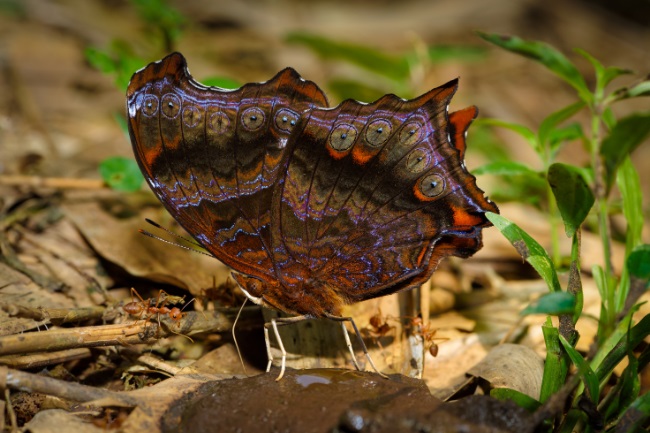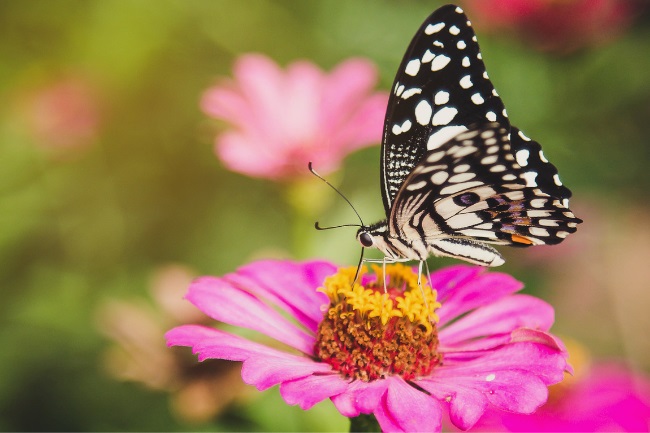Butterflies do not poop in the same way as humans do, instead, they release excess fluids when required. This is due to the fact that they eat a liquid diet of nectar, meaning they don’t have enough solid waste to form poops.
Contents
Do butterflies poop?

When it comes to butterflies we generally only see the sweeter side of these vibrant insects. While we may enjoy having butterflies fluttering about us or landing on our hands, it’s unlikely we would forgive them leaving us a brown stain when they lift off again.
It’s therefore lucky for both us and them that butterflies do not defecate as we do, and there wouldn’t be much left behind even if one did decide to relieve itself on you.
The poop of most mammals is fairly solid. This is because it is composed of leftovers from largely solid food, with much of the liquid extracted during its journey through the bowl.
Butterfly leftovers, by comparison, have a very different consistency. This is down to one very clear reason; diet.
Also read: What do Butterflies Eat and Drink? (Detailed Guide)
What do butterflies eat?

While the majority of caterpillars spend their time munching on leaves, an adult butterfly’s repass is very different.
Firstly it is entirely liquid. Adult butterflies, as we all know, feed on nectar from flowers. This nectar comes in a liquid form. It is produced by the nectaries of flowers, either within the flower itself or occasionally elsewhere on the plant.
Butterflies tend to visit the floral nectaries. Many flowers are even specially adapted for butterflies to feed from, with long thin shapes most suited to their drinking method.
Flowers have also adapted to use colours that will attract butterflies in, with reds and blues being particular colours butterflies are attracted to. Additionally, some flower markings are invisible to the human eye, only becoming obvious in infrared. These can add additional signals to the visiting insects that we are unaware of.
Some species of butterfly are very particular about the flowers they enjoy feeding from. However, this favouritism is generally more often noted in the caterpillars, with adult butterflies being happier to drink from a wider variety of flowers.
Also read: Here’s How and What Does a Butterfly Eat in The Winter
What is nectar?

Nectar is essentially a sugary liquid. It is a quick and easy source of energy for many animals. Butterflies, in particular, have a preference for it, though bees, hummingbirds and other species such as ants also enjoy this tasty snack.
Flowers manufacture nectar as a bribe for species to visit their flowers, helping to spread their pollen to other flowers. Sometimes nectar is also offered out in exchange for protection certain invertebrates can offer from pests.
Many flowers will only offer a small amount of nectar to each visitor, and then refill once this has been emptied. Cleverly some flowers will even change colour once they’ve been visited, encouraging insects to visit other nearby blooms.
Also read: Food and Feeding Habits of Hummingbirds?
Pee or poop?
Caterpillars produce small lumps or balls of hard faeces known as frass. These are the result of their high fibre diets. Butterflies by comparison drink large amounts of liquid, meaning they haven’t got much solid material to get rid of.
Because of this very watery diet, what butterflies produce instead is a much more fluid discharge. As we can’t define something so liquid as poop, the question is, is this pee instead? Technically, the discharge created by butterflies doesn’t have the same composition as urine, being largely excess water instead.
| Excess Fluid Type | Description |
|---|---|
| Meconium | Meconium is a dark, sticky substance excreted by newly emerged butterflies. It consists of metabolic waste accumulated during their pupal stage. |
| Excess Plant Juices | Butterflies consume nectar and plant juices, which can result in watery excreta containing excess fluids. |
| Hemolymph | Hemolymph is the insect equivalent of blood. In some cases, excess hemolymph can be released in butterfly excreta, particularly during times of stress or injury. |
| Excess Water | Butterflies may expel excess water in their excreta, especially after consuming water-rich food sources or during periods of high humidity. |
Butterflies certainly aren’t frequent toilet visitors, however. While the amount of liquid they drink certainly does mean they need to get rid of excess water, much of that excess fluid is lost through evaporation, escaping through their spiracles as they breathe.
Also read: Wondering if Ants Poop & Urinate? (Explained Here)
How do butterflies eat?

While caterpillars feed using their mouths to chomp away at vegetation, butterflies don’t have the ability to eat solid food. They have a long tube-like proboscis, which curls up when they aren’t using it.
Different species of butterflies can have different length proboscis, which can be perfectly adapted to their flowers of choice. In some species, their proboscis can be even longer than their bodies.
Lucky for us!
Flitting above us as they do we are perhaps lucky that butterflies do not need to regularly defecate. It might be hard to enjoy a pleasant picnic out amongst the meadow flowers if the threat of butterfly poop needed to be considered!
While caterpillars are poop creating machines, their older selves seem to have left such unpleasant behaviour behind them, with just a dainty tinkle required every now and then before they can get on with their day.

